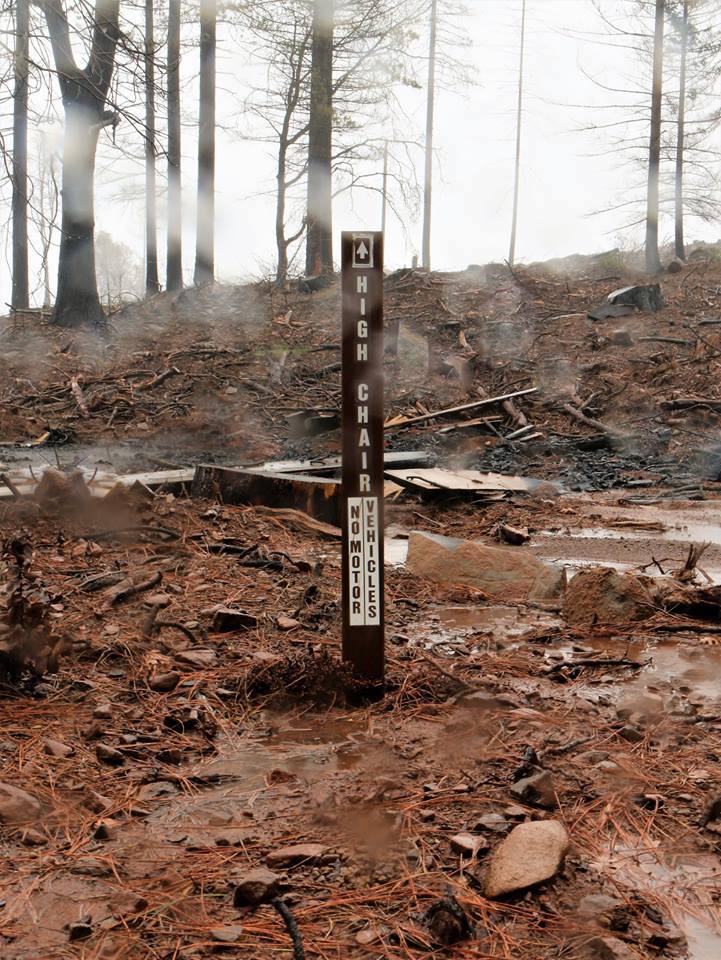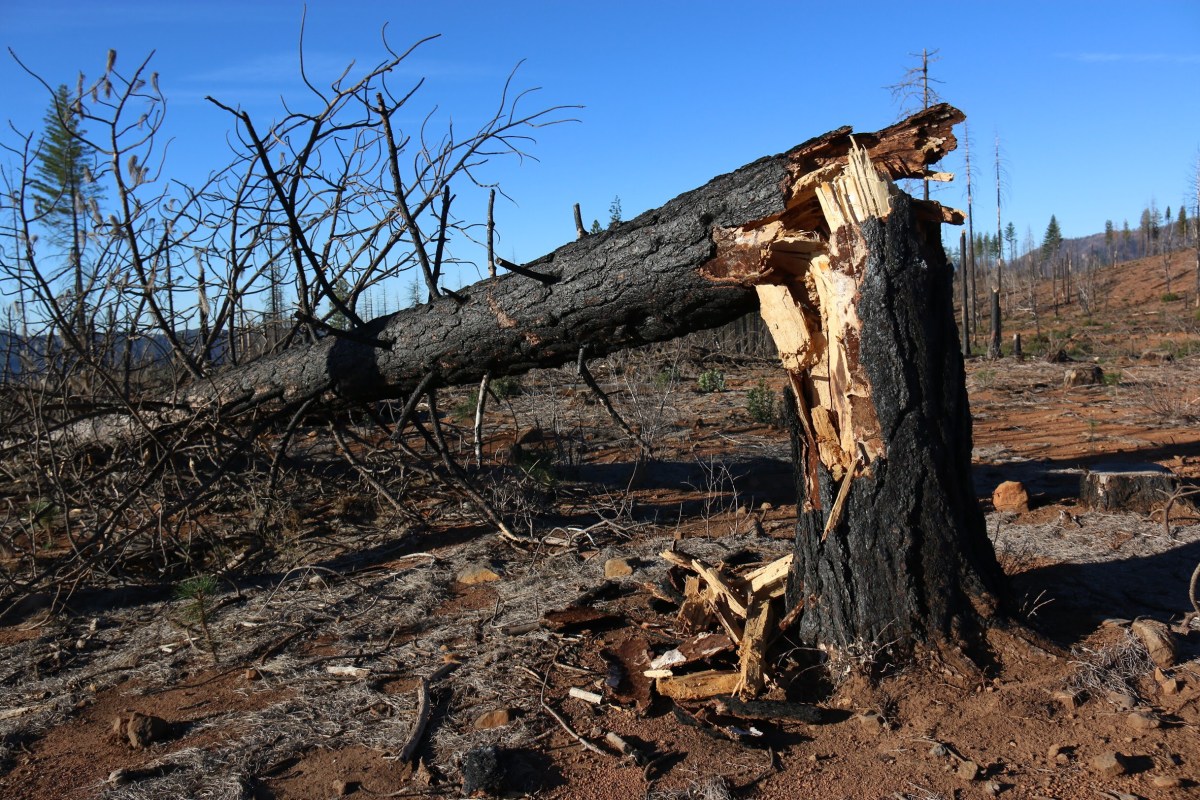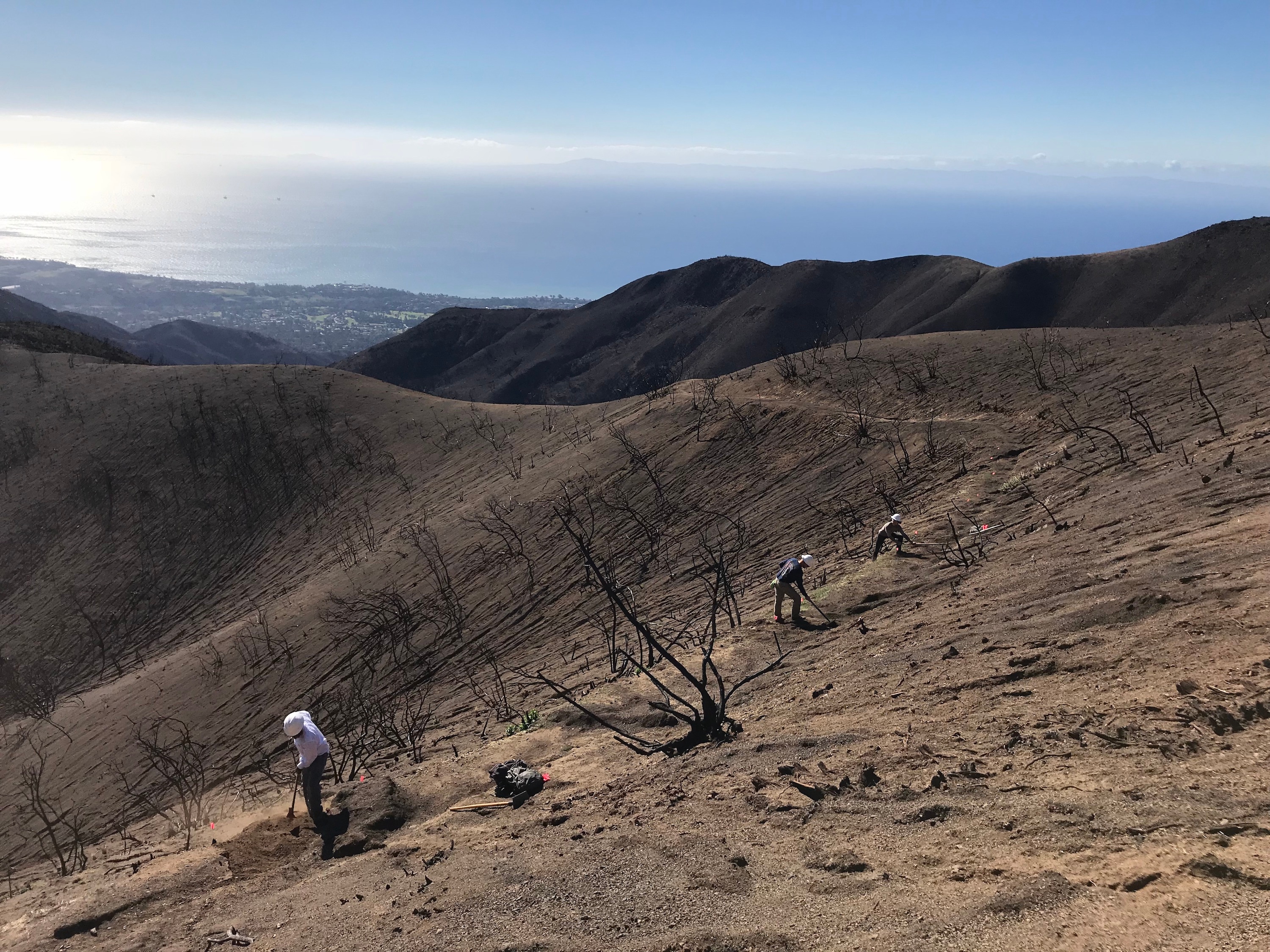Editor’s note: Trails are just one part of a community that must be cared for after a wildfire. This article focuses on the efforts communities in California have taken to rebuild trails following the Valley and Thomas fires in 2015 and 2017. REI is also contributing to efforts to help support the lives of those who have been impacted by wildfires this year, including those impacted by the devastating Camp Fire. Part of those efforts include a $20,000 contribution to the California Community Foundation’s Wildfire Relief Fund in support of immediate humanitarian needs.
On the day of the wildfire three years ago, Debbie Bloomquist was riding her road bike, training for a century ride on the roads that wind through the rolling hills near Cobb, in Northern California. It was a Saturday, and Bloomquist had planned a long route that would have taken her eight hours to ride. But early in the morning, she crashed, and the hard fall left her unconscious. When she woke up, she saw a man pulling her bike to the side of the road. An ambulance took her to the emergency room, and Bloomquist learned that she broke her collarbone and suffered a concussion. Her husband picked her up from the hospital. On the drive home, they saw a plume of smoke.
“I looked at my husband and said, ‘That is going up the hill toward our house,’” Bloomquist said.
The Valley Fire started just after 1pm that Saturday, Sept. 12, 2015, in a rural part of Northern California. Ultimately, the fire burned 76,000 acres and almost 2,000 structures. Four firefighters were injured, and four people died in the fire. Almost 1,300 homes were destroyed, including Bloomquist’s house. “Most everyone I knew lost their homes,” she said. A few days after the Valley Fire started, the Los Angeles Times called it “one of the worst in California history” for the pace at which it grew and the damage it caused. In the three years since, several California wildfires have exceeded the destruction of the Valley Fire. While writing this story, the Camp Fire in Northern California had just claimed the title of the most deadly and destructive wildfire in the state’s modern history.
“Our entire neighborhood was gone. Our town was gone,” Bloomquist said. “That craziness … trying to recover from an accident, then to deal with your home being gone, then we learned about Boggs a couple weeks later and learned how badly damaged the forest was.”
The same fire that destroyed her home, also destroyed the trails where she regularly rode her mountain bike. Boggs is a nearby demonstration forest. Bloomquist said it had a 22-mile network of trails that locals, including Bloomquist, used to hike or run or ride mountain bikes. Like many of us, Bloomquist said she took trails for granted. She says she had no idea what kind of work went into building trails, though she would soon find out. More than 98 percent of the 3,493-acre Boggs Mountain Demonstration State Forest was destroyed in the Valley Fire, according to Cal Fire, the state’s department of forestry and fire protection. When Bloomquist described the loss of the local trails, she said it was like getting hit in the heart twice.
“In life, we all deal with stress. We deal with anxiety. Our relief is to go ride our bikes on trails, or go run, or hike, or ride a horse,” said Bloomquist, who is 45 years old and is the treasurer for the Friends of Boggs Mountain, a regional group that is working to restore trails destroyed in the Valley Fire. “When you go through a natural disaster, you feel all of those things you may feel. You have all of these emotions that are constant in your mind and in your physical body, and when you don’t have your trail system, there’s no release. You’re not only dealing with this tragedy that struck your community, you’re also dealing with this fact that you have no release like you’re used to. That’s gone.”

The High Chair trailhead in February 2017, a year and a half after the Valley Fire scorched the Boggs Mountain Demonstration State Forest. (Photo Credit: Debbie Bloomquist)
After a wildfire, there is no single method for how to rebuild trails. Often, the work and the funding becomes the responsibility of local volunteer groups who rally together to restore a public asset. Each organization finds their own way to raise money, to navigate the public land management of their particular forest, to prioritize which trails or infrastructure projects need to be done first. In Northern California, Bloomquist said there is dialogue between groups in Boggs, Sonoma and Napa counties, and to the north in the redwoods.
In some cases, the loss of an old thing created an opportunity to build something new, and perhaps better. In Southern California, where the Thomas Fire raged through more than 281,000 acres of a coastal mountain range, a local nonprofit hopes to rebuild trails in a way that will make them more accessible to a broader range of people.
“Nobody walks into rebuilding trails after a wildfire as an expert,” Bloomquist said. “You go through it once, and you navigate your way through the craziness.”

After the Valley Fire, viewpoints throughout Boggs Mountain appeared, says Bloomquist. This photo was taken in October 2018. (Photo Credit: Debbie Bloomquist)
One year ago, the Thomas Fire and succeeding mudslides transformed the landscape in the coastal mountains that frame Santa Barbara and Ventura counties. At that time, it was the largest wildfire in California history and it destroyed more than 1,000 structures, as well as 125 miles of trails throughout the region.
In Santa Barbara and Montecito, the trails were historic, said Mike Tarpey, president of the board of the Santa Barbara Mountain Bike Trail Volunteers (SBMTV). The 30-year-old organization maintained trails in Santa Barbara and Montecito that could be traced back to homesteads and Native American passages.
“These aren’t trails that have been built in the last 20 years,” Tarpey said. “These are all trails that have been carved into the mountain for decades and decades.”
But wildfires and mudslides pay no attention to historic legacy. In some instances in Santa Barbara and Ventura counties, the trails were erased off the mountainside entirely. Suddenly, the volunteer workload shifted from trail maintenance to trail building.
“About 50 percent of the trails are reopened and usable and in good shape,” Tarpey said. “But in other places, there is just huge engineering [work]—boulder-moving, rock-blasting, helicopter-dropping work—that needs to be done to bring some of these trails back into the fold.”
The cost to rebuild trails throughout the region is estimated at seven figures, Tarpey said. To support the work being done by city, county and federal agencies that manage the land the trails are located on, the SBMTV joined a coalition of nonprofits, businesses and agencies in Ventura and Santa Barbara counties that are actively helping to rebuild trail networks. The Thomas Fire Trail Fund has a $1 million goal. Out of the tragedy, a new precedent has been set that encourages collaboration and cooperation. Tarpey also said there is now an opportunity to design new trails that are more accessible to a wider range of abilities—perhaps improving the riding altogether.
“People have banded together,” Tarpey said. “You see that, out of the ashes, the rising up. Is it an opportunity to rebuild the trails in a more sustainable way that enhances recreation and opens up opportunities to more user groups? That is being discussed.”
REI is part of the coalition. Sylvia Schnopp, REI’s outdoor programs and outreach market coordinator in Ventura, orchestrated the coalition’s first meeting in the beginning of February. Schnopp said that, in total, REI has donated $55,000 to nonprofit partners specifically for trail restoration and rebuilding in Santa Barbara and Ventura counties.
“Although this specific project—the Thomas Fire/Debris Flow Advisory REI Recovery Group—was not necessarily in my job description, as an REI employee I was empowered to create something new, reflecting on the track record created by other REI markets like Denver, when they responded a few years ago to flooding in their community,” Schnopp said.

A fallen tree after a windstorm in October 2018 on Boggs Mountain. Crews are just beginning to evaluate the work ahead to rebuild the trails. (Photo Credit: Debbie Bloomquist)
After the Valley Fire burned through the Boggs Mountain Demonstration State Forest, the extent of damage was so great that forest officials shut down public access to the forest for three years so they could work on reforestation, according to Cal Fire. Because Boggs was a demonstration forest for logging, the process to reopen to the public took longer, said Peter Leuzinger, the Boggs Mountain forest manager. In 2017 and 2018, Cal Fire planted 702,695 trees using seeds collected from Boggs. Then, in July 2018, Boggs finally reopened to the public for recreation on a day-use basis. However, recreation is limited to the existing road system, said Leuzinger. “Most of the trail system was obliterated,” he said.
Bloomquist remembers riding her mountain bike on the trails through Boggs several times a week. She said they were mostly flow trails, covered with pine needles, with a few technical sections. She’d recognize familiar faces—other bikers but also runners and hikers. “I know people who lost weight out there. I know people who had debilitating anxiety who no longer had a place to go,” she said.
Before the fire, the forest was so thick Bloomquist said she often felt engulfed by the trees. Now, she sees the view. “You can see views that you never knew were there,” she said. “It was shocking, the devastation. I don’t think there was any way to articulate what it looked like to see a hillside that was covered with pine trees be nothing but dirt and stumps.”
Bloomquist said she took several trips to the forest before she started to really notice the regrowth. She saw wild lilies and tiny flowers that were no bigger than the tip of her pinkie finger. She sat on a fallen log and saw green plants growing inside of burned holes all over a dead piece of wood. “The earth does take care of itself,” she said. “Every time I go out there and I see that, it reminds me that we’re all going to be OK.”
Pending the approval of an environmental report, Bloomquist and the Friends of Boggs Mountain are recruiting volunteers to start rebuilding all 22 miles of trails. In the meantime, they are raising money. REI gave the Friends of Boggs Mountain a $10,000 grant to rebuild trails immediately after the fire. In total, the group has about $80,000—a quarter of its funding goal. In addition to contracting a professional multi-use trail builder, who will also train volunteers, the funds will be used to buy equipment and tools to outfit 15 to 20 people, including rogue hoes, chainsaws, safety eyewear, hand tools, rock bars, shovels, trailers to carry it all, and more.
“Our goal is to not have this be a 30-year project but to get the trail system in as soon as possible,” Bloomquist said. “It depends on funding and capacity.”
The trails and the work days have to be approved by Cal Fire, but volunteers will do the chainsaw work and the digging. Hand crews will clear fire slash and debris. Spring 2019 will be a huge push to rebuild.
“I never realized how I took trails for granted, how I took the communities for granted,” Bloomquist said. “I had no idea the impact the trail systems have on a community—economically and from a mental health standpoint.”
On Sept. 22, 2018, the Friends of Boggs Mountain held a membership drive with a barbecue in the one section of the forest that was untouched by the fire. About 130 people showed up to support the group. “It was really great to see people with smiles on their faces,” Bloomquist said. “I was really optimistic about how many people could see the beauty of it.”
At the time of publication (December 19, 2018), REI had contributed $25,000 to Northern California communities impacted by the Valley Fire, and $55,000 to communities in Santa Barbara and Ventura counties affected by the Thomas Fire.


